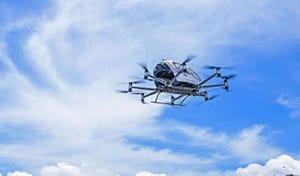'Brainless' Robot Navigates Without Human, Computer Intervention
The soft robot uses an asymmetrical design and heat-sensitive materials to enable autonomous movement through an obstacle course

Researchers from North Carolina State University have created a “brainless” soft robot that can autonomously navigate without human or computer guidance.
The work builds on a previous design from the university team, though the first iteration had limited navigation capabilities, and was unable to turn unless it hit an obstacle.
With the new design, the robot can navigate with greater autonomy and orient itself even around moving obstacles.
"In our earlier work, we demonstrated that our soft robot was able to twist and turn its way through a very simple obstacle course," said Jie Yin, co-corresponding author on the study. "However, it was unable to turn unless it encountered an obstacle. In practical terms this meant that the robot could sometimes get stuck, bouncing back and forth between parallel obstacles.
"We've developed a new soft robot that is capable of turning on its own, allowing it to make its way through twisty mazes, even negotiating its way around moving obstacles. And it's all done using physical intelligence, rather than being guided by a computer."
Physical intelligence means the robot relies on its structure and material composition to achieve certain behaviors, as opposed to being controlled by human or computer intervention.
The researchers tested the new robot design on both a metal surface and in sand.
The robot is created using “ribbon-like” liquid crystal elastomers, which contract when placed on a warm surface to create a rolling motion that moves it forward. In contrast to the initial design, the new iteration is asymmetrical, giving it a wider range of motion and preventing it from getting stuck between objects.
“Because of its asymmetrical design, it turns without having to come into contact with an object,” said Yao Zhao, first author of the study. “So, while it still changes directions when it does come into contact with an object – allowing it to navigate mazes – it cannot get stuck between parallel objects. Instead, its ability to move in arcs allows it to essentially wiggle its way free.”
According to the team, the design could be useful in developing navigation techniques for soft robots, with particular use cases in energy harvesting robots.
“This work is another step forward in helping us develop innovative approaches to soft robot design – particularly for applications where soft robots would be able to harvest heat energy from their environment,” Yin said.
About the Author
You May Also Like








